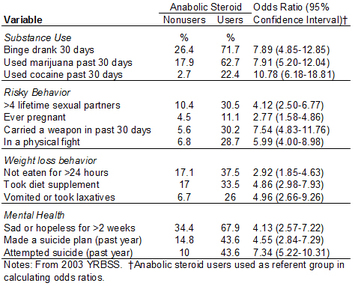During recent years, Centers for Disease Control and Prevention (CDC) researchers have observed an increase in prevalence rates of adolescent females’ self-reports of anabolic steroid use and other risky behaviors. These risky behaviors include, binge drinking, drug use, sexual behavior, and violence in school (Grunbaum et al., 2004). For decades, researchers, health advocates, and the general public have associated these issues as being a “male problem” (Bahrke, Yesalis, & Wright, 1990; Egan, 2002; Potteiger & Stilger, 1994; “SCOUTING; School Lesson About Steroids”, 1985) and targeted interventions for these activities primarily to males (See STASH Vol. 2(5)). In this weeks’ STASH, we examine the anabolic steroid use of female high school students and its effect on various health behaviors.
Elliot et al. (2007) conducted an analysis of the CDC’s 2003 Youth Risk Behavior Surveillance System (YRBSS) dataset comparing health outcomes of steroid users to non-users among girls (N=7,447) in grades nine through twelve. The YRBSS sampled participants using a three-stage cluster design (U.S. Region x School x Classroom) drawing a nationally representative sample of students in grades 9-12. Participants completed a 95 question anonymous self-report survey regarding general health, substance use, violent behavior, and mental health. Researchers conducted a logistic regression to estimate the association between anabolic steroid use and risky health behaviors; covariates in this analysis included race/ethnicity, grade level, and team sports participation.
About 5% (5.3%) of female U.S. high school students reported using anabolic steroids during their lifetime. As Table 1 shows, adolescent female anabolic steroid users are more likely than female non-anabolic steroid users to also abuse other substances, engage in risky sexual behavior, attempt to lose weight in unhealthy ways (e.g., not eating for more than 24 hours), and suffer from recent depressive episodes and suicide attempts. Researchers found participating in team sports to be a protective factor against anabolic steroid use, meaning those who participated in team sports were significantly less likely to use anabolic steroids (OR, 0.52; 95% CI,0.34-0.80).
Figure. Comparing prevalence estimates of health-related behaviors for female U.S. high school students according to anabolic steroid use (Adapted from Elliot et al., 2007). Click image to enlarge.
This study is not without limitations. Researchers utilized a cross-sectional design. A cross-sectional study allows researchers to ask questions about behavior and health outcomes during one point in time, does not allow examination of temporal relationships, and, therefore, limits our ability to understand causal influences. The YRBSS data is based upon self-report, potentially leading to under-reporting of risky health behaviors and outcomes. In addition, researchers only included participants who were present in school in their analysis. Adolescents who do not attend school might engage in the most risky behaviors. If so, then this data evidences conservative estimates of risky health behaviors.
Despite these limitations, the prevalence of risky health behaviors among female students reporting anabolic steroid use raises important pubic health concerns. These results suggest three things. (1) Female students using steroids might suffer from underlying psychiatric problems, requiring a more extensive treatment program such as counseling. (2) Those who participated in team sports were less likely to use anabolic steroids, potentially indicating that women’s sports empower girls to make better health choices. These healthy choices might be mediated by increased self-esteem. (3) It is possible that these results might be due in part to a greater awareness of the dangers of anabolic steroid use among female student athletes. The benefits related to girls’ participation in team sports deserves further study. In the meantime, school administrators and health advocates should consider implementing anabolic steroid treatment and prevention programs specific to adolescent females.
What do you think? Please use the comment link below to provide feedback on this article.
Reference
Bahrke, M. S., Yesalis, C. E., 3rd, & Wright, J. E. (1990). Psychological and behavioural effects of endogenous testosterone levels and anabolic-androgenic steroids among males. A review. Sports Medicine, 10(5), 303-337.
Egan, T. (2002). Body-Conscious Boys Adopt Athletes’ Taste for Steroids [Electronic Version]. The New York Times. Retrieved 12/5/2007 from http://query.nytimes.com/gst/fullpage.html?res=9E00E3DF1239F931A15752C1A9649C8B63&sec=&spon=&pagewanted=all#.
Elliot, D. L., Cheong, J., Moe, E. L., & Goldberg, L. (2007). Cross-sectional study of female students reporting anabolic steroid use. Archives of Pediatrics & Adolescent Medicine, 161(6), 572-577.
Grunbaum, J. A., Kann, L., Kinchen, S., Ross, J., Hawkins, J., Lowry, R., et al. (2004). Youth risk behavior surveillance–United States, 2003. MMWR Surveill Summ, 53(2), 1-96.
Potteiger, J. A., & Stilger, V. G. (1994). Anabolic Steroid Use in the Adolescent Athlete. Journal of Athletic Training, 29(1), 60-64.
SCOUTING; School Lesson About Steroids. (1985). Retrieved December 5, 2007, from http://query.nytimes.com/gst/fullpage.html?sec=health&res=9A0DE3D91430F936A35755C0A960948260&n=Top/News/Health/Diseases,%20Conditions,%20and%20Health%20Topics/Steroids





